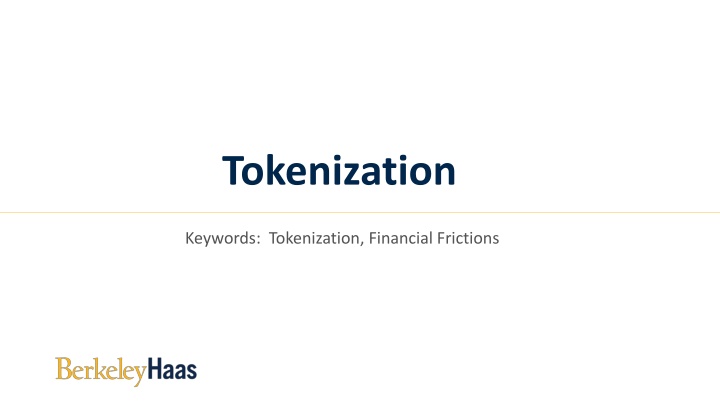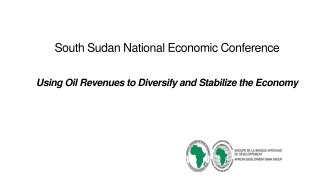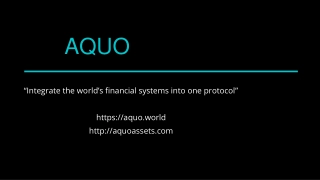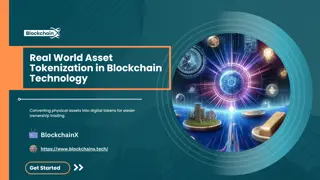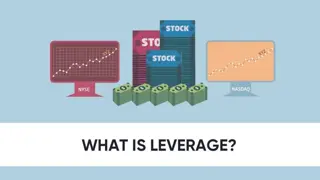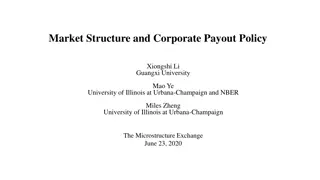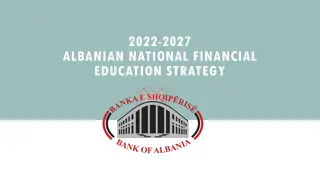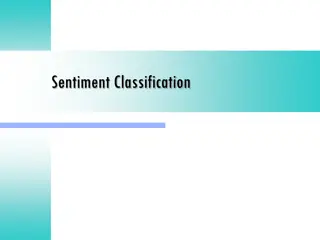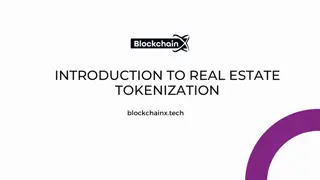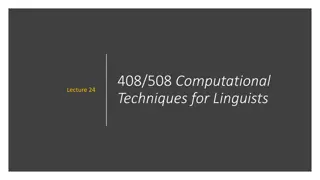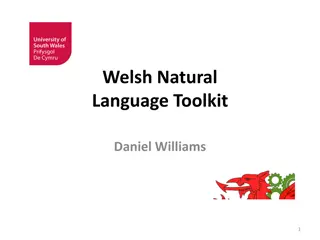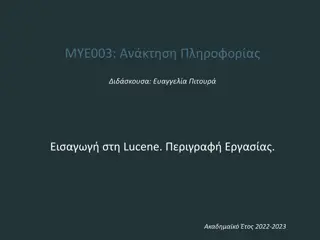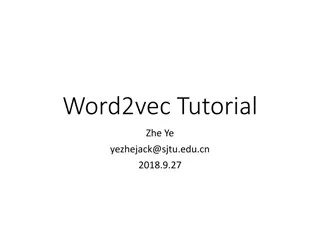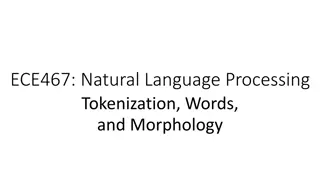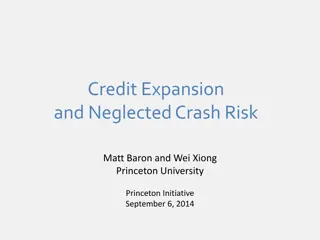Addressing Financial Frictions Through Tokenization
Tokenization serves as a solution to the limited connectivity between decentralized finance and traditional finance, helping to streamline processes, reduce settlement costs, and enhance efficiency in financial transactions. By tokenizing assets and leveraging blockchain technology, the industry is exploring innovative ways to overcome existing challenges, such as settlement uncertainty, collateral requirements, and cross-border payment inefficiencies. With experiments underway and a focus on economic benefits, the long-term prospects of tokenization are promising in reshaping the financial landscape.
Download Presentation

Please find below an Image/Link to download the presentation.
The content on the website is provided AS IS for your information and personal use only. It may not be sold, licensed, or shared on other websites without obtaining consent from the author.If you encounter any issues during the download, it is possible that the publisher has removed the file from their server.
You are allowed to download the files provided on this website for personal or commercial use, subject to the condition that they are used lawfully. All files are the property of their respective owners.
The content on the website is provided AS IS for your information and personal use only. It may not be sold, licensed, or shared on other websites without obtaining consent from the author.
E N D
Presentation Transcript
Tokenization Keywords: Tokenization, Financial Frictions
Overview Limited on and off ramps between decentralized finance and traditional finance. What are the problems that tokenization could solve? What are experiments are happening? What are the long term prospects of these experiments?
Frictions in Financial Transactions - I Transfers payment Payment moves separately from instrument Settlement takes xx working days Record keeping separate from messaging Transfers instrument
Settlement costs: Opportunity Cost of Collateral Banks have to pre-fund transaction accounts and traders have to pre- fund settlement accounts. Collateral sits in accounts and cannot be used in trading/other activities. Cost is the opportunity cost Return you could have made if used elsewhere.
Economic Costs in current system Settlement uncertainty Collateral has to be posted e.g., cross border payments or central counterparties Opportunity cost of capital Securities have to be moved between sub-custodians Fails/system mismatch Limited Time windows Jump Risk when markets are closed
Cost example: Cross-border payments The process of of transferring value can cost up to 7% of the transaction value. Efficiency enhancements to increase speed and reduce the need for collateral. Source: Inthanon LionRock Report
Explicit Costs: Custody Source: SEC
Frictions in Financial Transactions - II Cash flows Issuance Securitize or payoff
Explicit Costs: Loan Servicing Source: SEC
Models of Tokenization 1. Native tokens Assets issued on-chain Flexibility to design new types of assets (token is code) Legal and regulatory issues 2. Non-native tokens Financial institution holds RWA in custody Issues tokens against them Requires trust in the institution
Native Tokens HSBC Orion Regulated under Luxembourg digital asset/blockchain legislation Central Account Keeper (CAK) like a CSD (Central Securities Depository) Issue wallets and initiates transfers Hyperledger but mirrored on Ethereum Settlement token (specific payments not generalized) Floating rate bond with the European Investment Bank (EIB)
Goldman Sachs Digital Asset Platform: GS DAP EIB issued 100 million Euro 2 year digital bond on Goldman Sachs GS DAP Jan 2023 HK monetary authority issued 100 million green bond using GS protocol. DvP (Delivery versus payment) using a Hashed Time Lock Integrated into the Canton network which synchronizes across siloed blockchains
Economic Implications of Digital Native Can reduce direct costs of issuing, custody and servicing. If the blockchain permits different protocols (trade, lending) increase secondary market liquidity and use value of the asset. Assets are more valuable if they have multiple uses Interoperability is very important, else blockchain operator has market power. Form of interoperability is important else credit risk.
Real World Assets (RWA) on chain Custodian holds the RWA and issues a token Tokenization to increase secondary market liquidity Tokenization to allow fractionalization. Tokenization makes it easier to switch and use collateral Align Technological transfer with title transfer (no fails)
Broadridge Distributed Ledger Repo Existing connections to securities depositories and custodians Tokenize collateral Payment through conventional rails but occurs at the same time as settlement ``atomic Source: Broadridge.com
DLT Repo Smart contracts provide flexibility on terms etc. Direct cost savings on reconciliation Reduce risk (fails, credit etc.) Increased collateral mobility Easy for Broadridge to convert custody relationships to tokenize collateral and deploy smart contracts on a DL
Finance/Economic Implications Successful: 50 bn daily or 1 trillion a month Intraday Repo are easy to implement Many are intra-company repos Does this have an aggregate effect on collateral usage/demand? Does this make banks more/less resilient?
Hamilton Lane tokenizes investment products On Polygon Partnership with Securitize (which will manage these) Issue tokens against illiquid alternate assets such as RE, art etc. Reduce costs and make it easier to offer smaller smaller investment sizes. Tap deeper capital markets
. Also Ondo Finance Tokens that are claims to an open end fund i-shares short term Treasury and some cash holdings Convenience yield of Defi payments. Easier and faster to redeem If liquid stablecoin that bears interest! Potential competition to interest bearing deposit accounts
Finance/Economic Implications RWA For Investor: Buy alternate asset classes with a smaller minimum investment Assets more liquid and easier to use as collateral. For firms/issuers Potentially decrease cost of capital (reduction in direct costs) Increase investor base Reduces monitoring incentives potentially increase cost of capital
Regulated Liabilities Regulated financial industries are designing products that can be used for payments. Competition with stablecoins Citi has proposed a Regulated Liability Network National currencies or regulated liabilities Interoperable Prevents dollarization
USD Forward (USDF) A bank issued (private) stablecoin Advantages are that it is cheaper than existing services. Potentially also programmable Factoring etc. Bridge to Crypto Source: USDF Website
Citi Token Citi Token: Deposits are tokenized and can be used for cross-border payments 24/7 Cash Management and Trade finance. HQLA (by Goldman Sachs): DLT R3 Corda Collateral management for Institutional Clients Delivery versus Delivery (no cash)
Questions around Systemic Risk Are slow financial systems better? Are automated systems less secure? How should regulators interact with enterprise blockchain? Are tokenized assets more fragile? What changes should be made in securities law/regulation?
Conclusion Existing financial system has embedded costs Experiments underway to redesign financial infrastructure Tokenizing assets can make the system run more smoothly. Potentially leads to unanticipated risks.
